Poison ivy is a leafy groundcover or vine often found growing in gardens, yards, and forest trees. Yet while it might look pretty, this plant produces an oily resin known as urushiol. Urushiol can cause people who interact with the root, stem, or leaves of a poison ivy plant to experience an allergic reaction. If you touch any part of the poison ivy plant, you may find your skin becoming red and itchy, breaking out in a rash, swelling, or blistering. This reaction can be extremely itchy and even painful, and can easily last for a week or two.
Since most people are allergic to urushiol, it is important to avoid touching poison ivy. In order to avoid any unfortunate encounters with poison ivy plants in your yard or garden, be sure to correctly identify the plant and remove it. To help you do so, this article rounds up a list of some of the homemade poison ivy killers you can use to successfully and quickly get rid of poison ivy at your home.
Just whip up one of these homemade solutions and apply it to the plant! Carefully killing poison ivy in your yard is one of the best ways to reduce the risk of an itchy or painful exposure! To help you do so, this article summarizes some of the different strategies you could take to address poison ivy in your yard or garden. Let’s jump in to discover the most effective homemade poison ivy killers, starting by learning a bit about what poison ivy is.
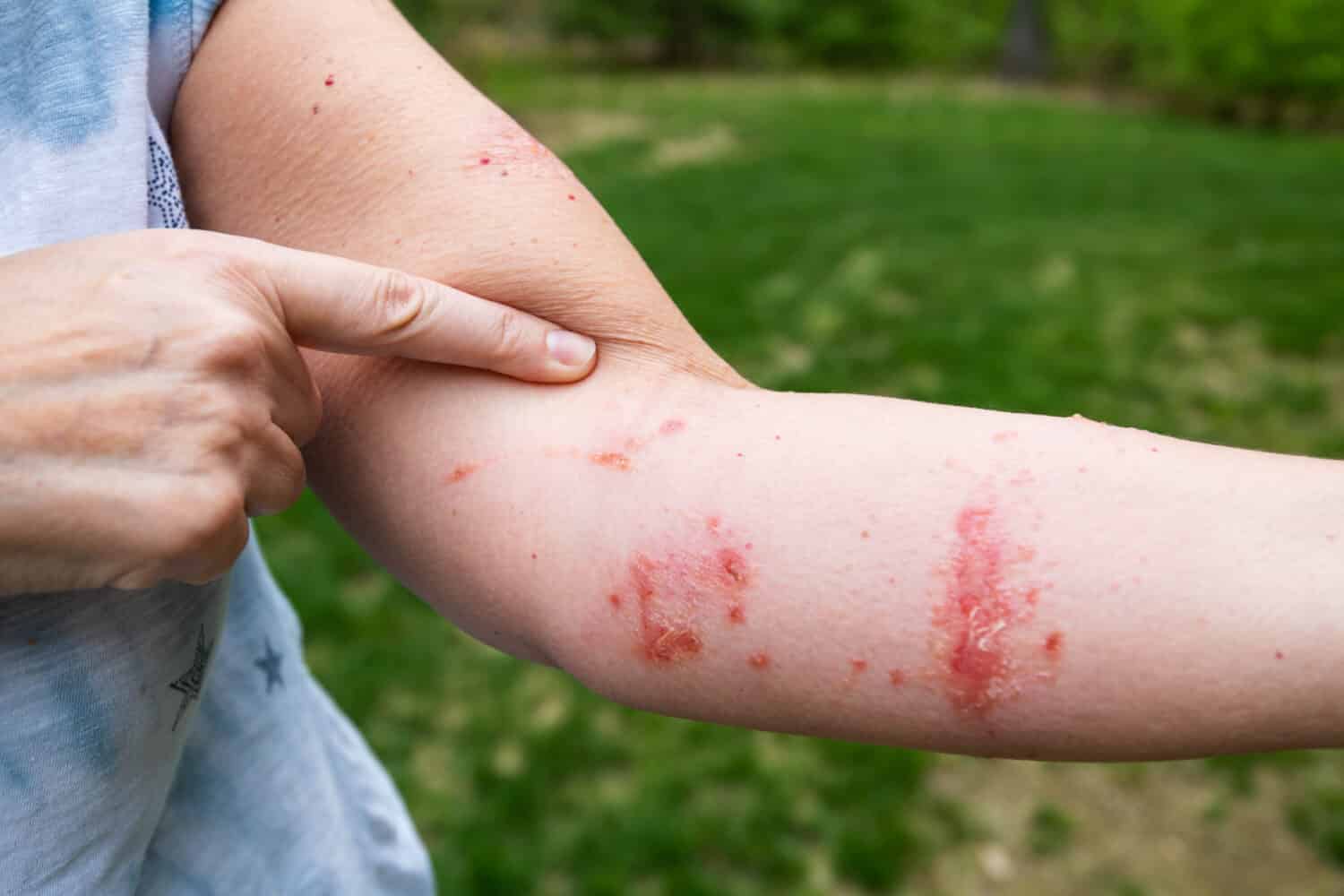
Poison ivy can cause a very painful rash if your skin comes into contact with any part of the plant.
©Michael Moloney/Shutterstock.com
What Is Poison Ivy?
The plant known as “eastern poison ivy” or simply “poison ivy” is the species Toxicodendron radicans. This toxic plant is also closely related to some other species, poison sumac, and poison oak, which also produce allergic reactions in the people who encounter them. Poison ivy appears throughout every part of the United States, except for Hawaii and Alaska. It is especially prevalent in forested areas or swampy landscapes, where it thrives in moisture. It is most common in the southeast and midwestern states.
You can identify poison ivy by looking for broad, tear-shaped leaves that grow in groups of three. It usually grows close to the ground, though this “ivy” plant also grows as a vine that wraps around tree trunks or climbs up other structures. Though many expect poison ivy to be green, it changes color over the course of the year. Poison ivy starts off as red in the spring, becomes green in the summer, and darkens into orange and then brown in the fall and winter. However, urushiol is always present in all parts of poison ivy. Whether the plant you see is thriving and green or a withered brown vine, urushiol can still cause a reaction on your skin.
You may also realize that a plant is poison ivy when an encounter with a vine’s leaves, stems, or roots causes your skin to break out into a painful rash — triggered by the yellow oil, urushiol, secreted by the poison ivy plant.
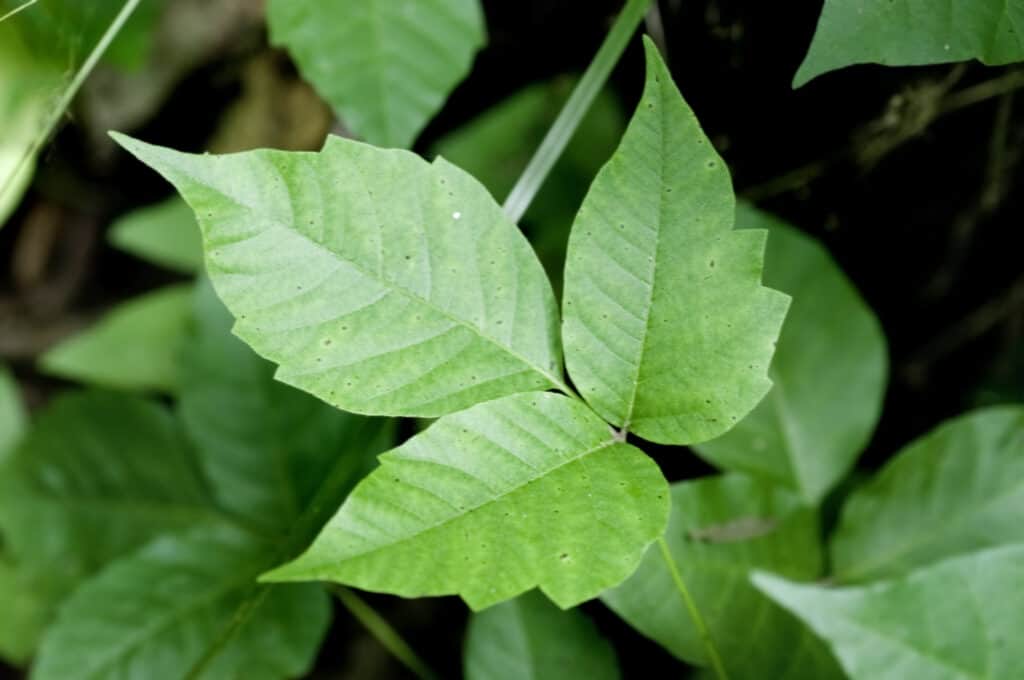
Poison ivy has compound leaves consisting of three individual leaflets.
©Tim Mainiero/Shutterstock.com
Removing Poison Ivy from Your Yard
Though fear of getting a rash can prevent some landscapers or gardeners from addressing the problem of poison ivy head-on, do not be afraid! You can remove poison ivy in the same way you would tackle removing another weed or vine from your yard — just with a few extra precautions. There are several main methods to remove poison ivy, in addition to a few less common strategies. Here are a few of the top ways to remove poison ivy from your yard.
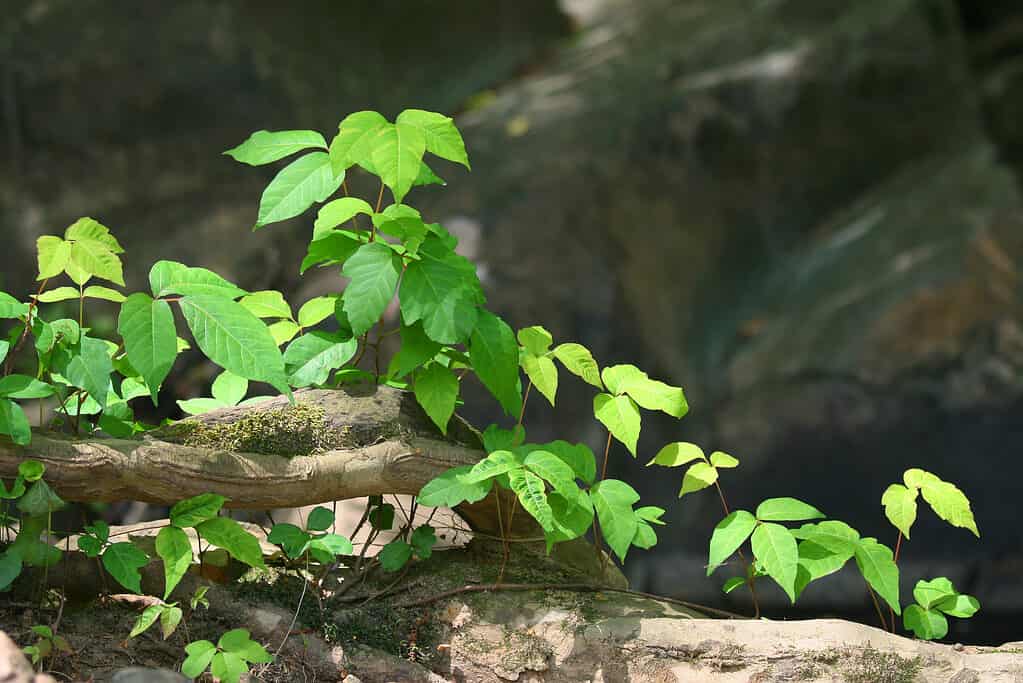
Poison ivy grows throughout the continental United States but is especially prevalent in the southeast.
©iStock.com/email2ying
Removing Poison Ivy with Herbicides
You can remove poison ivy using herbicides, which can rapidly kill poison ivy and cover a large area quickly. Some of the most effective herbicides contain glyphosate. This chemical has the ability to penetrate the poison ivy plant and kill it. Usually, the herbicide you choose can be sprayed on the leaves. This makes spraying the solution less labor-intensive than weeding by hand, and makes it less likely that healthy roots will stay in the soil and come back in the future.
However, you may not want to choose a chemical herbicide due to environmental concerns or other convictions against using a toxic solution that can damage a yard or even contribute to illnesses for humans exposed to it. If you choose this method, be sure to read the labels and directions closely before use. Some of the products you buy that can help to control poison ivy may also have a negative impact on the plants you want to keep in your yard or garden!
Removing Poison Ivy by Weeding
Those who want to avoid herbicides may choose to tackle poison ivy by weeding. This is one of the most effective ways to remove poison ivy since careful weeding allows you to completely eradicate the plant by digging the roots up from the soil. From there, you can discard all of the plant material through your waste removal system. However, this method does require wearing gloves, long sleeves, and even head and face protection to ensure you do not accidentally come into contact with the poisonous plant parts. You will also want to carefully wash your clothes and clean your tools to ensure that the poison ivy oils do not cause a rash later.
Removing Poison Ivy by Calling an Expert
If you worry about getting a rash from poison ivy, do not worry. You do not have to handle it yourself! You can always call an expert to come and remove the poison ivy for you. However, going this route is not cheap. Poison ivy removal can easily cost between $300 to $700. Be sure to ask for a price quote up-front. Though many companies can give a quote via phone or email, they may want to visit your home or yard to see the situation to give you an accurate estimate. This is the most expensive way to remove poison ivy, but it is one way to make sure the job is done right and safely.
Removing Poison Ivy by Making a Homemade Weed Killer
Another way to remove poison ivy, aside from calling a landscaper to handle the problem for you, is by making your own homemade weed killer. This will involve using noxious chemicals to kill the plant. The next section of this article will cover some of the recipes you can use to make homemade poison ivy killers.

Poison ivy is prevalent in many forested areas and swamps found in state and national parks.
©iStock.com/HABesen
Homemade Poison Ivy Killer Recipes
Those who want to use an at-home recipe to kill poison ivy have a few options to choose from. It is important to remember that though homemade solutions can be a good all-natural route and a way to involve more toxic chemicals, their effectiveness may vary. The recipes below may not work consistently depending on your specific environmental conditions or the ingredients you use. You may also find that poison ivy is a particularly resilient plant! Just remember that if you choose to make a “DIY” poison ivy killer, you may need to tackle the poison ivy in multiple rounds of treatment. The key is to be more patient and persistent than the poison ivy is!
Boiling Water Method
One way to kill poison ivy is by using boiling water. Simply add tap water to a kettle, heat to boiling temperatures, and then pour the water over the poison ivy plants. Cover the roots and leaves of the plant thoroughly. This will scald and drown the roots.
Vinegar and Salt Method
Another tactic you can use to remove poison ivy is to make a vinegar and salt solution. Simply mix one gallon of white vinegar with a cup of salt. Stir thoroughly until the salt dissolves, then add the solution to a spray bottle. You can spray this salt and vinegar solution onto the leaves of a poison ivy plant, covering them thoroughly.
Vinegar, Salt, and Dish Soap Method
You can build on the recipe above by using one gallon of water with one cup of salt one tablespoon of vinegar, and one tablespoon of dish soap. Stir thoroughly, add the solution to a spray bottle, and spray all over your poison ivy plant!
Dawn Dish Soap Method
If you don’t have any vinegar on hand, you can try using plain old dish soap. Mix ¼ of a cup of Dawn dish soap with a gallon of water. Stir the two together and then incorporate three pounds of salt. Next, use a spray bottle to spray the solution onto the poison ivy plant. It may take multiple applications to successfully kill the poison ivy.
Gin Method
Another method for addressing unwanted poison ivy is a more complex recipe. Use two ounces of gin mixed with one ounce of apple cider vinegar, one tablespoon of dish soap, and one quart of water. Mix all of the ingredients together thoroughly, pour the solution into a spray bottle, and spray it directly onto the poison ivy leaves.
Bleach Method
The next method is effective, but one you will want to do carefully! Bleach can be a good way to kill poison ivy. Be sure to wear protective clothing and gloves when you pour bleach together with water in a 1:10 ratio. Pour the solution onto the poison ivy leaves.
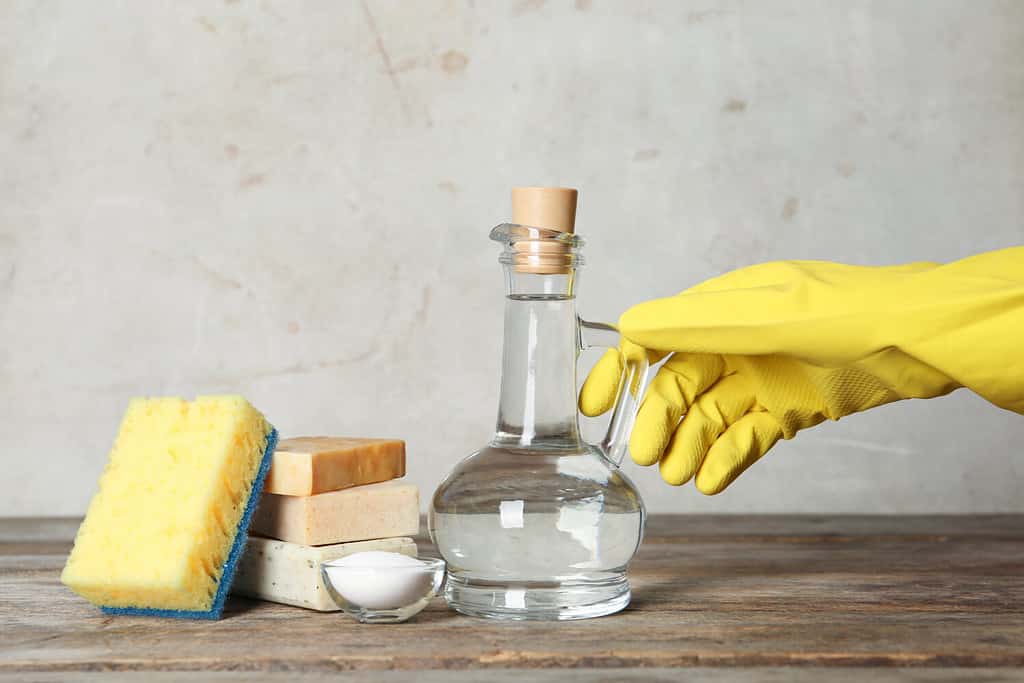
Making a solution with vinegar and salt to spray on poison ivy is one popular recipe for removing the plant.
©New Africa/Shutterstock.com
Other Strategies for Removing Poison Ivy
If none of the recipes above appeal to you, there are a few other options you can use to remove poison ivy.
Have you considered renting a goat? Goats have a reputation for eating everything! They will happily chomp on the vines and leaves of any poison ivy they find. However, they will not be able to eat the whole underground root system, so you may find that the plants grow back year after year.
You could also try the suffocation method. Plants like poison ivy cannot thrive without air, water, and light. You can cover the poison ivy with cardboard, weigh the material down, and leave the cardboard in place for several months.

Goats will eat just about anything, so some people use the animals to chew down poison ivy in their yards.
©danhusseyphoto/Shutterstock.com
The Best Strategy for Removing Poison Ivy
Which of these is the best strategy for removing poison ivy? Well, expert advice may vary. Using any homemade weed killer is going to take determination and patience, and you can expect to go back multiple times before the plant is totally eradicated.
However, using the recipe for vinegar and salt poison ivy killer may be one of the best strategies. Simply use your gallon of water, one cup of salt, one tablespoon of dish soap, and one tablespoon of vinegar to make a solution to spray all over the bad poison ivy plant. Repeat this as necessary!

Poison ivy leaves turn orange and then brown in the fall, but they can irritate your skin no matter how green or how dead the leaves look!
©FotoCat99/Shutterstock.com
Bad Strategies for Removing Poison Ivy
Even if you do not want to do any of the strategies listed above, there are a few methods to remove poison ivy that you definitely do not want to do.
First, never burn poison ivy! Inhaling the smoke from a bonfire or brush pile that contains poison ivy, poison oak, or poison sumac can cause significant respiratory problems and severely harm your nasal passages and lungs.
Second, if you do use pruners to try to prune out poison ivy, do not tear or rip the plant vines. This can cause the urushiol to go airborne.
Third, if you pull the poison ivy out by hand, avoid adding it to your compost. While it can break down, the urushiol could still remain and be harmful. Keep it completely separate from your compost by bagging your poison ivy up, and leave it for the professionals to take away with the rest of your yard waste.
Fourth, if you use an herbicide, do not later attempt to take the poison ivy out yourself by hand. If you do that, you will put your skin at risk of harmful contact both with the poison ivy and the chemicals in the herbicide.
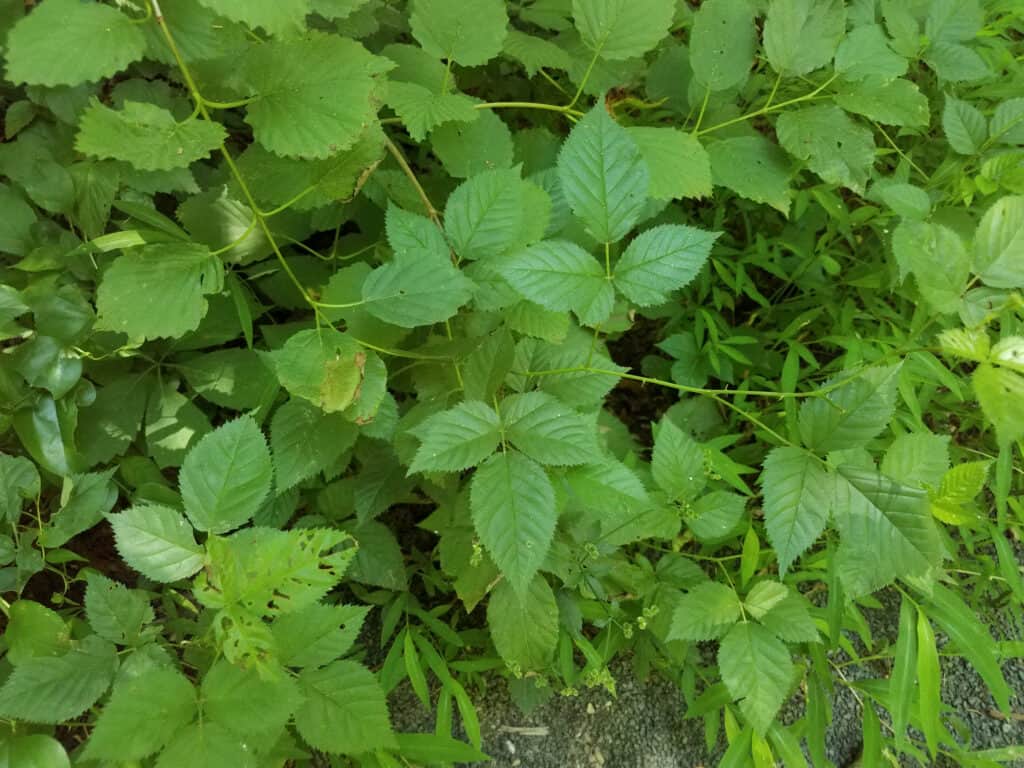
Poison ivy is well known for causing a painful and itchy skin rash.
©iStock.com/Justin Smith
Conclusion
In summary, be on the lookout for poison ivy when hiking or working in your yard, as it can cause a painful rash on your skin. While it is a good idea to remove it, always be careful when handling poison ivy or its relatives, poison oak or poison sumac. With some diligence, using one of the recipes in this article can help you to successfully remove poison ivy from your yard. Remember, after you work with poison ivy or attempt to use any chemicals, carefully wash your tools using rubbing alcohol or vinegar. Wash your clothes separately from other articles of laundry, and wash your shoes using soapy water. Be sure to also wash your hands thoroughly in cold water.
If you do find your skin reacting to a poison ivy rash, you can use calamine lotion or over-the-counter steroid cream to treat it. If the itching and rash persist, you can always consult your doctor, who may prescribe a stronger cream or other treatment.
With these tips in mind, you should be ready to tackle your poison ivy problem. Good luck!
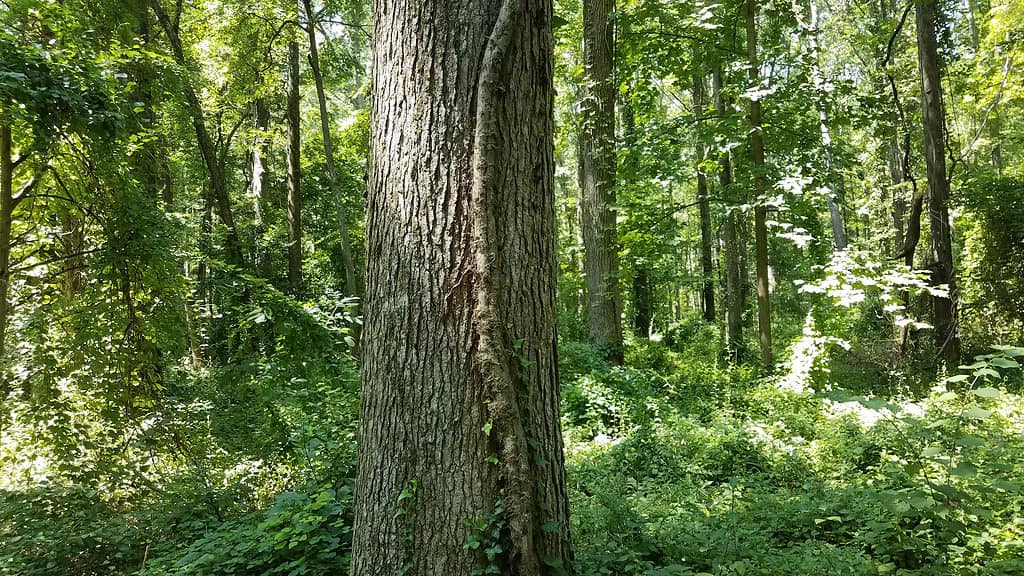
Poison ivy grows as groundcover and as a vine that runs up the trunks of trees.
©iStock.com/Justin Smith
The photo featured at the top of this post is © Mark van Dam/Shutterstock.com
Thank you for reading! Have some feedback for us? Contact the AZ Animals editorial team.






